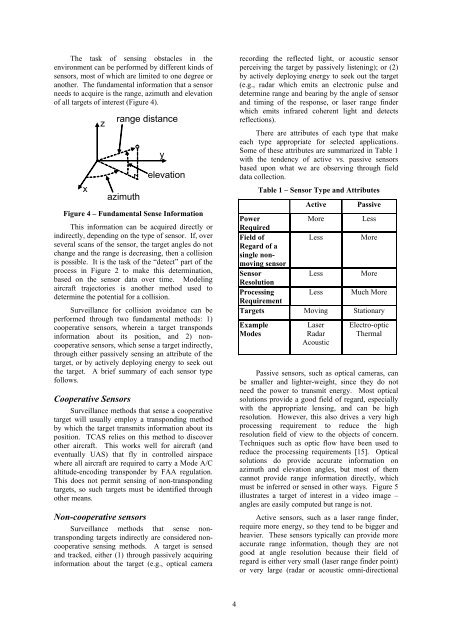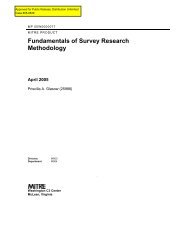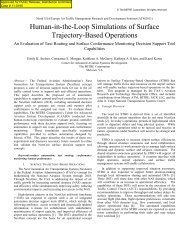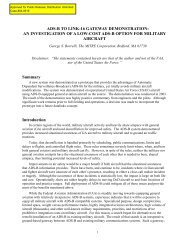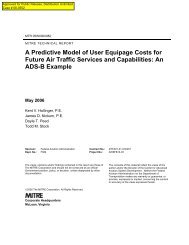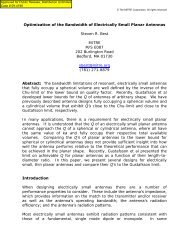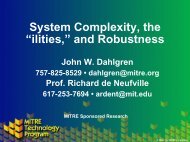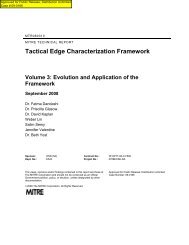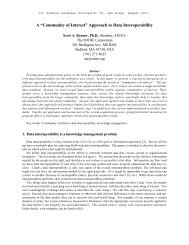Unmanned Aircraft Collision Avoidance: Technology ... - Mitre
Unmanned Aircraft Collision Avoidance: Technology ... - Mitre
Unmanned Aircraft Collision Avoidance: Technology ... - Mitre
You also want an ePaper? Increase the reach of your titles
YUMPU automatically turns print PDFs into web optimized ePapers that Google loves.
The task of sensing obstacles in the<br />
environment can be performed by different kinds of<br />
sensors, most of which are limited to one degree or<br />
another. The fundamental information that a sensor<br />
needs to acquire is the range, azimuth and elevation<br />
of all targets of interest (Figure 4).<br />
x<br />
z<br />
range distance<br />
azimuth<br />
y<br />
elevation<br />
Figure 4 – Fundamental Sense Information<br />
This information can be acquired directly or<br />
indirectly, depending on the type of sensor. If, over<br />
several scans of the sensor, the target angles do not<br />
change and the range is decreasing, then a collision<br />
is possible. It is the task of the “detect” part of the<br />
process in Figure 2 to make this determination,<br />
based on the sensor data over time. Modeling<br />
aircraft trajectories is another method used to<br />
determine the potential for a collision.<br />
Surveillance for collision avoidance can be<br />
performed through two fundamental methods: 1)<br />
cooperative sensors, wherein a target transponds<br />
information about its position, and 2) noncooperative<br />
sensors, which sense a target indirectly,<br />
through either passively sensing an attribute of the<br />
target, or by actively deploying energy to seek out<br />
the target. A brief summary of each sensor type<br />
follows.<br />
Cooperative Sensors<br />
Surveillance methods that sense a cooperative<br />
target will usually employ a transponding method<br />
by which the target transmits information about its<br />
position. TCAS relies on this method to discover<br />
other aircraft. This works well for aircraft (and<br />
eventually UAS) that fly in controlled airspace<br />
where all aircraft are required to carry a Mode A/C<br />
altitude-encoding transponder by FAA regulation.<br />
This does not permit sensing of non-transponding<br />
targets, so such targets must be identified through<br />
other means.<br />
Non-cooperative sensors<br />
Surveillance methods that sense nontransponding<br />
targets indirectly are considered noncooperative<br />
sensing methods. A target is sensed<br />
and tracked, either (1) through passively acquiring<br />
information about the target (e.g., optical camera<br />
4<br />
recording the reflected light, or acoustic sensor<br />
perceiving the target by passively listening); or (2)<br />
by actively deploying energy to seek out the target<br />
(e.g., radar which emits an electronic pulse and<br />
determine range and bearing by the angle of sensor<br />
and timing of the response, or laser range finder<br />
which emits infrared coherent light and detects<br />
reflections).<br />
There are attributes of each type that make<br />
each type appropriate for selected applications.<br />
Some of these attributes are summarized in Table 1<br />
with the tendency of active vs. passive sensors<br />
based upon what we are observing through field<br />
data collection.<br />
Table 1 – Sensor Type and Attributes<br />
Active Passive<br />
Power<br />
Required<br />
More Less<br />
Field of<br />
Regard of a<br />
single nonmoving<br />
sensor<br />
Less More<br />
Sensor<br />
Resolution<br />
Less More<br />
Processing<br />
Requirement<br />
Less Much More<br />
Targets Moving Stationary<br />
Example<br />
Modes<br />
Laser<br />
Radar<br />
Acoustic<br />
Electro-optic<br />
Thermal<br />
Passive sensors, such as optical cameras, can<br />
be smaller and lighter-weight, since they do not<br />
need the power to transmit energy. Most optical<br />
solutions provide a good field of regard, especially<br />
with the appropriate lensing, and can be high<br />
resolution. However, this also drives a very high<br />
processing requirement to reduce the high<br />
resolution field of view to the objects of concern.<br />
Techniques such as optic flow have been used to<br />
reduce the processing requirements [15]. Optical<br />
solutions do provide accurate information on<br />
azimuth and elevation angles, but most of them<br />
cannot provide range information directly, which<br />
must be inferred or sensed in other ways. Figure 5<br />
illustrates a target of interest in a video image –<br />
angles are easily computed but range is not.<br />
Active sensors, such as a laser range finder,<br />
require more energy, so they tend to be bigger and<br />
heavier. These sensors typically can provide more<br />
accurate range information, though they are not<br />
good at angle resolution because their field of<br />
regard is either very small (laser range finder point)<br />
or very large (radar or acoustic omni-directional


